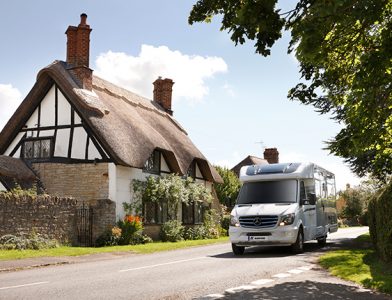Buying a motorhome is an exciting venture that opens up a world of travel possibilities. However, it also requires careful planning and consideration. Here’s what you need to know when buying a motorhome …
Think carefully about why you are buying one
We’re in no way suggesting that you begin to question your decision to invest in a motorhome. Far from it. Instead, we’d just like you to be sure you understand what you expect to get out of your motorhome – because that will tell you how you are going to use it.
That, in turn, will inform your thinking about the type of motorhome that is likely to be suitable for your needs. If you plan to use your motorhome regularly for long-distance trips around Europe and with several passengers aboard, for example, you are likely to incline towards certain types of vehicle over others.
By contrast, if you are planning to use your motorhome only occasionally in the UK and just over the summer months you are likely to adopt a different approach. This leads us on to the different types of motorhome available.
The different types of motorhomes
Motorhomes come in various types, each catering to different needs:
1. Coachbuilt motorhomes: These are typically built on a van or truck chassis and have a custom-made body. They are spacious and often feature separate living, dining, and sleeping areas.
2. Campervans: Smaller and more manoeuvrable, campervans are typically built on a standard van chassis with a converted interior. They are ideal for short trips and city driving.
3. A-Class motorhomes: These are luxury models with a fully integrated body and chassis. They offer the most living space and amenities but typically come at a higher cost.
4. Compact motorhomes: Similar to campervans but with more features and space. They strike a balance between size and comfort.
5. Conversion vans: Standard vans that have been converted into living spaces. They are often customised according to individual needs and can vary widely in quality and layout.
Prepare your finances
Once you have the type of vehicle in mind, whether that is brand new or pre-used, you should start to get a reasonable understanding for the ballpark figure you will probably need to pay for that type of motorhome.
It’s always advisable to be sure in advance just how you plan to finance your motorhome (you can use our free motorhome finance calculator). Apart from providing you with peace of mind, it also means you’ll be able to focus on driving a hard deal with the sell.
Further reading: Motorhome finance Faqs.
Don’t over-compromise on quality
Economy is always going to be a big issue for any buyer but cutting back on space or facilities in order to save perhaps a modest amount of money, might be something you’ll regret later on. Compromises may, of course, be necessary but go with your instinct where things such as fittings, furnishings and little luxuries are concerned.
How much does a motorhome cost?
The cost of a motorhome can vary greatly depending on its type, size, age, and condition. Here are some key financial considerations:
1. Initial purchase price: New motorhomes typically range from £40,000 to over £100,000. Used motorhomes can be cheaper, but it’s important to check their condition and history.
2. Running costs: These include fuel, motorhome insurance, road tax, and maintenance. Plus, storage. Fuel efficiency can vary, so consider a model that balances performance with economy.
3. Insurance: Motorhome insurance is essential and can be more expensive than standard vehicle insurance due to the higher value and contents of the motorhome.
4. Depreciation: Motorhomes depreciate over time, although less so than many cars. A well-maintained motorhome can retain its value better.
Inspection and condition
Before purchasing a motorhome, a thorough inspection is crucial:
1. Exterior condition: Check for signs of rust, damage, and the condition of the windows and seals. Pay particular attention to the roof and undercarriage for any signs of water ingress or structural issues.
2. Interior condition: Inspect the living area for wear and tear, particularly in frequently used areas like the kitchen, bathroom, and sleeping areas. Check for dampness or mould, which can indicate water leaks.
3. Mechanical condition: Ensure the engine and mechanical components are in good working order. Look for service history and consider having a professional mechanic inspect the vehicle.
4. Mileage: Lower mileage can indicate less wear and tear, but it’s not the only factor. Consider how the motorhome has been used and maintained.
5. Service History: A full service history provides insight into the maintenance and care the motorhome has received. Look for regular servicing and any major repairs or replacements.
Legal considerations
Understanding the legal aspects of owning a motorhome is essential:
1. Driver’s Licence: The good news is that many motorhomes can be driven on a standard driving licence. However, the position isn’t always entirely straightforward, as the weight of a motorhome plus the date you passed your test, might both have an impact on the type of vehicle you can drive on that standard licence. Check your driving eligibility on the official government website here.
2. MOT and Tax: Ensure the motorhome has a valid MOT certificate and is taxed. The MOT must be renewed annually for vehicles over three years old.
3. Insurance: Motorhome insurance is mandatory. Ensure the policy covers not only the vehicle but also its contents and any accessories. Breakdown cover is also highly recommended.
4. Parking and storage: Consider where you will park and store your motorhome when it’s not in use. Some residential areas have restrictions, and secure storage can add to your costs. Remember that local laws and your insurance policy might prohibit you from permanently parking your motorhome on the public highway when it is not in use. Similarly, parking on your driveway or in your back garden might be an easy route to losing friendly relations with your neighbours. There are often easy solutions to this type of challenge – just be sure you have thought through the issues in advance.
Comfort and usability
When choosing a motorhome, think about how you will use it:
1. Living space: Evaluate the layout to ensure it meets your needs. Consider the number of berths (sleeping areas), the kitchen facilities, and the bathroom. Some motorhomes offer separate showers and toilets, while others have combined wet rooms.
2. Storage: Adequate storage is essential for long trips. Check for cupboards, lockers, and external storage compartments.
3. Seating and sleeping arrangements: Make sure the seating is comfortable and can be easily converted into sleeping areas if necessary. Fixed beds offer more comfort but take up more space.
4. Amenities: Modern motorhomes come with various amenities such as fridges, ovens, heating systems, and entertainment systems. Ensure these are working correctly and meet your needs.
5. Accessibility: Consider how easy it is to access and move around the motorhome, particularly if you have mobility issues.
Test drive
A test drive is crucial to ensure the motorhome is comfortable and easy to drive:
1. Handling: Pay attention to how the motorhome handles on different types of roads. Larger motorhomes can be challenging to manoeuvre in tight spaces.
2. Comfort: Ensure the driving position is comfortable and that visibility is good. Check the functionality of mirrors and any reversing aids.
3. Performance: Assess the engine’s performance, braking, and suspension. Listen for any unusual noises and check for smooth gear changes.
4. Features: Test all onboard systems, including heating, water, and electrical systems, to ensure everything is working correctly.
After-sales support
Consider the after-sales support provided by the dealer or seller:
1. Warranty: Check if there is any remaining manufacturer’s warranty or if the dealer offers a motorhome warranty. Understand what is covered and for how long.
2. Servicing and repairs: Find out where you can get the motorhome serviced and repaired. Some manufacturers have approved service centres.
3. Parts availability: Ensure that spare parts are readily available, especially if the motorhome is an older or imported model.
4. Resale value: Consider the potential resale value of the motorhome. Well-known brands and models typically retain their value better.
At Derbymotorhomes, we offer full after-sales support.
Final considerations
Don’t emotionally commit based on photos alone. All manufacturers understandably show their products in the very best light in their publicity material. Try to avoid losing your heart to a given motorhome based on that input alone.
There is absolutely no substitute for hard research into the models you are thinking about and, at the same time, getting your hands on them for a personal inspection and test drive.
A motorhome that looks fantastic in an online photograph and presentation might feel completely different to you once you can get to know it up close and personal, perhaps by driving in for an hour or two. So, keep an open mind from the outset. So:
1. Try before you buy: If possible, rent a similar motorhome for a short period to see if it suits your needs.
2. Research: Join motorhome clubs and online forums to gain insights from experienced owners. They can provide valuable advice and recommendations.
3. Negotiation: Don’t be afraid to negotiate the price, especially if you are buying a used motorhome. Consider additional costs such as accessories or modifications you might need.
Buying a motorhome is a significant investment, but with careful planning and consideration, it can provide years of enjoyment and adventure. Ensure you do your homework, take your time, and make an informed decision to find the perfect motorhome for your needs.




